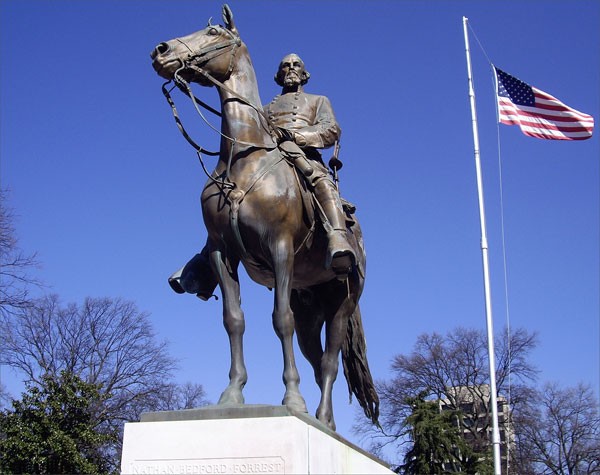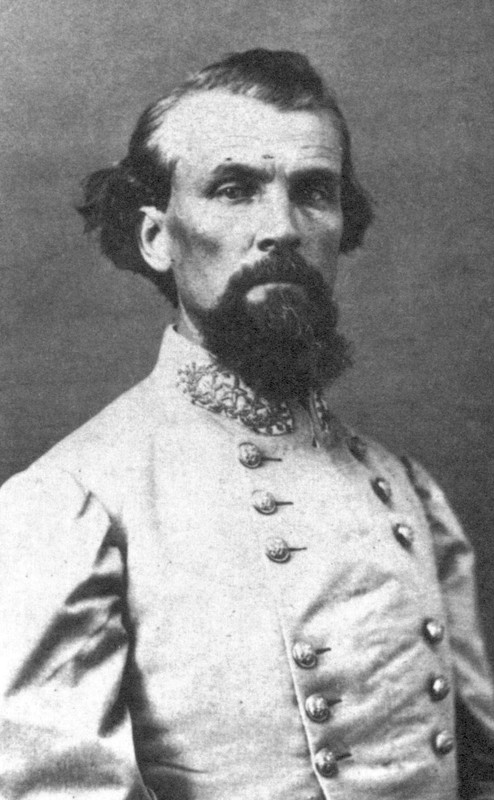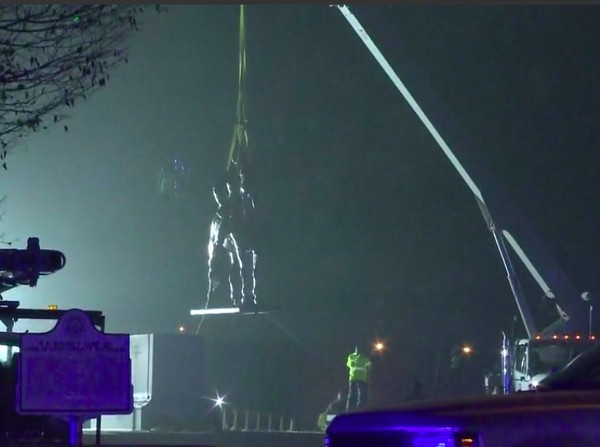Nathan Bedford Forrest Statue and Burial Site (1905-2017)
Introduction
Text-to-speech Audio
Dedicated in 1905 and removed in 2017, this was the site of a statue of Nathan Bedford Forrest, a controversial figure in his own time and in recent history. Forrest made a fortune trading slaves before the Civil War and led a massacre of Black Union Troops after they surrendered at Fort Pillow. Forrest was also the founder and the first Grand Wizard of the Ku Klux Klan, although he later left the organization when it became "too violent" in his view. In 1904, the bodies of Forrest and his wife were moved from Elmwood Cemetery and were placed near the statue. Many white and Black residents oppose the monument given Forrest's career as a slave trader, his alleged war crimes, and his role in the Ku Klux Klan. The Tennessee Historical Commission once rejected Memphis City Council’s recommendation to remove the statue despite the wishes of many residents. The monument was removed on December 21, 2017 by Memphis Greenspace Inc. after Memphis City Council sold the Health Sciences Park, where the monument stood, to Greenspace Inc. for $1,000.
Images
The statue in Health Sciences park in Memphis, TN

Nathan Bedford Forrest

The Nathan Bedford Forrest Monument being removed on December 20, 2017 by Memphis Greenspace Inc.

Backstory and Context
Text-to-speech Audio
Nathan Bedford Forrest was born in Chapel Hill, Tennessee on July 13, 1821. Forrest's family were of modest means which at that time meant that the children had no opportunity for a formal education. Forrest was motivated and demonstrated a talent for business and went into business with his uncle. Forrest's early wealth came from the slave trade and he maintained one of the most notorious slave pens in the city.
Forrest rose to prominence during the Civil War, where he served as a general despite a lack of military training. Forrest earned a reputation as a competent military leader and a ruthless fighter. The General was known for the saying “get there first with the most men” and was sometimes referred to as “the Wizard of the Saddle.” Most infamously, Forrest is known for his attack on Fort Pillow in April of 1864, when he is believed to have massacred Black soldiers after they had surrendered.
In the last 1860s, Forrest helped form the Ku Klux Klan. The organization began as a fraternal order for Confederate veterans. Like many Southern whites, Klan members were angered by the enfranchisement of African Americans after the war. The organization soon began committing atrocities against African Americans, although Forrest denied that he ever ordered or participated in a violent attack during his years with the Klan when he was called to testify before the Joint Congressional Committee in 1871.
In 1971, the state created a law that declared July 13th as “Nathan Bedford Forrest Day.” That law has not been repealed, but the recent national campaign to remove Confederate monuments has brought attention to this holiday, monument, and the proper place of Nathan Bedford Forrest in Tennessee history. 63% of Memphis residents are African American and the City Council has recommended the removal of the monument. In 2016, the Memphis City Council voted unanimously to exhume Forrest’s remains and begin the process of removing the monument. The city renamed Forrest Park to Health Sciences Park in 2015.
City Council Chairman Myron Lowery declared that “[the statue is] a symbol of racism, of bigotry, and hatred – there’s no need to honor a man that massacred people at Fort Pillow, there’s no need to honor a man who received his millions of dollars and fame from being a slave-trader.” In October 2016, the City's effort to move the statue was stifled by the Tennessee Historical Society, whose executive director said she had “no idea” the memorial existed until publicity from the shooting at Emanuel Church in Charleston, SC “brought attention to such proclamations.”
The Tennessee Heritage Protection Act of 2013 bars cities from relocating, removing, renaming, or otherwise disturbing war memorials on public property. This law was passed by a Republican majority in the state legislature specifically to bar cities from removing statues. Ironically, this action which removes local authority has been supported by many Confederate supporters who claim that their support of the Confederacy is based on its support for local government. With the power to override cities and counties, the mostly-white Historical Commission denied the City’s application for waiver of the law.
On December 20, 2017, the Memphis City Council sold the Health Sciences Park to Memphis Greenspace Inc for $1,000. Once the Health Sciences Park was owned by Greenspace Inc., they were legally able to remove the Forrest monument later that day on December 20, 2017. The Chief Legal Officer Bruce McMullen said the monument would be placed in an undisclosed location for security purposes.
The Memphis Greenspace Inc. is a nonprofit led by Van Turner, Shelby County Commissioner and attorney. Memphis Mayor Jim Strickland said the purchase of the park, removal of the statue and Greenspace’s future maintenance of the park is all privately financed. Strickland said the park will remain open to the public.
The statue was erected in 1905 as an “enduring moment” to Forrest. The Tennessee Historical Commission has provided the park's historical nomination form. Throughout twenty-nine pages of detail both about the park and the statue itself, the report does address the controversy surrounding Forrest. The document says that the naming of the park (Forrest Park) was suggested two years after the land's development by the president of the Confederate Historical Association in honor of "CSA General and Memphian Nathan Bedford Forrest." In describing Forrest and the surrounding controversy, the nomination form reads:
The namesake of the park and of the statue in the park that bears his name was Lt. General Nathan Bedford Forrest, a bold and brilliant cavalry officer for the Confederate army whose daring raids against Union forces in Mississippi and Tennessee raised him to a position of great respect, and perhaps even dread, among his Union peers. Even today, Forrest’s military tactics are studied by military historians and his exploits celebrated by Civil War enthusiasts (though his role and the circumstances in the directing forces against Fort Pillow [NHL 5/30/74] and killing of a high number of the fort’s African American troops is still fiercely debated.) Prior to the war, Forrest built a personal fortune as a plantation owner and slave dealer in Memphis; after the war, he became the first Grand Wizard of the Ku Klux Klan, and its aim to reestablish Democratic Party rule in the South in the wake of the liberal Republican rule imposed under Reconstruction. For these aspects of his career, Forrest is vilified by many as well, particularly among African Americans.
It is often difficult to separate the actions and events leading to the development of Forrest Park as a city park, and the actions and events leading to the development of Forrest Park as a place to house the envisioned Forrest statue. The end result turned out to be essentially the same, but one must keep in mind that the statue came about as the result of private, non-profit efforts of many years in length, while the park’s development occurred along a timetable set by circumstances of city government and also affected by some outside forces. The sequences of events on both parts leading up to the dedication of the statue in Forrest Park in 1905 did not necessarily mesh in a logical pattern of development.
Sources
Miller, Jay. Nathan Bedford Forrest Statue Won't Be Relocated. knoxnews.com. Oct 21, 2016. Accessed April 22, 2017. http://www.knoxnews.com/story/news/local/tennessee/2016/10/21/nathan-bedford-forrest-wont-be-moved/9....
Nathan Bedford Forrest. History Channel. Accessed April 22, 2016. http://www.history.com/topics/american-civil-war/nathan-bedford-forrest.
Glenza, Jessica. Nathan Bedford Forrest Day honoring key figure in KKK divides Tennesseans. The Guardian. July 13, 2015. Accessed April 22, 2017. https://www.theguardian.com/us-news/2015/jul/13/nathan-bedford-forrest-day-tennessee-racism-civil-wa....
Poe, Ryan. Memphis removes Confederate statues from Downtown parks. Commercial Appeal. December 20, 2017. Accessed September 03, 2018. https://www.commercialappeal.com/story/news/government/city/2017/12/20/memphis-council-votes-immedia....
Downs, Ray. Memphis city council sells two parks to remove Confederate statues. UPI. December 21, 2017. Accessed September 03, 2018. https://www.upi.com/Memphis-city-council-sells-two-parks-to-remove-Confederate-statues/7201513836353....
Harrelson, Nina. "THERE GOES FORREST: The statue of the Confederate general and Klan leader was removed at 9:01 p.m." Arkansas Times, December 20, 2017, https://www.arktimes.com/ArkansasBlog/archives/2017/12/21/mempbis-removes-Confederate-statues-by-sel...
